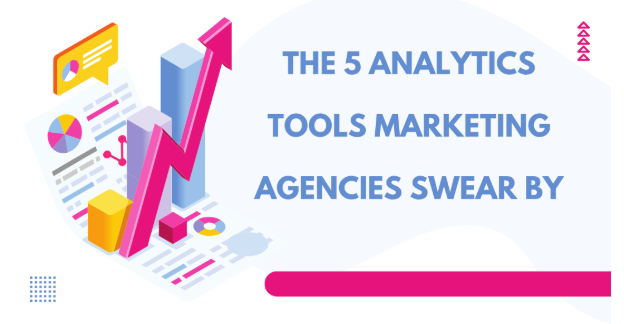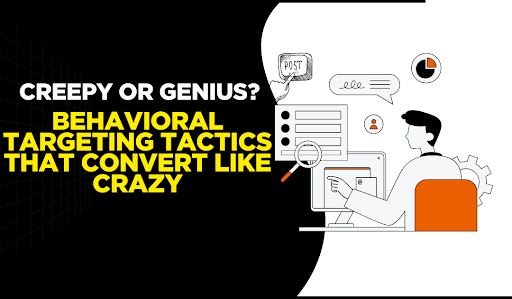The 5 Analytics Tools Marketing Agencies Swear By (And the One That’s Secretly Killing Your ROI)
- eyal297
- Aug 2
- 5 min read
Data in 2025 has become more than just a competitive edge; it forms the basis of all effective marketing strategies. Yet while marketers now possess more analytics tools than ever, many still operate without complete visibility into how well their strategies perform.
Discovering exactly how your audience behaves and using this knowledge to drive decisions are two keys to transforming average campaigns into ROI-shattering successes. That is where behavioral targeting in marketing comes in--along with supporting analytics tools that make this possible.

In this post, we'll go over:
These top five analytics tools are relied upon by agencies.
How these tools utilize behavioral targeting in marketing to increase conversions
One popular platform could actually be draining your budget.
Improve Your Marketing Strategy.
Let's dive right in.
Why Behavioral Data Is More Valuable Than Ever
Before discussing tools, let's quickly explore behavioral targeting in marketing.
Behavioral targeting takes advantage of consumer digital behavior such as page visits, email opens and purchase history to customize messaging and offers that address actual behavior rather than generalized demographic data or guesswork. Instead of targeting demographic factors or making assumptions based on guesswork alone.
Results? Greater engagement, superior return-on-investment (ROI), and smarter campaigns.
With recent changes to privacy regulations and cookie restrictions sweeping through, collecting first-party data to apply behavioral targeting marketing through suitable analytics platforms becomes even more essential.
1. Google Analytics 4 (GA4) Agencies Love It:
GA4 has quickly become the industry standard in web analytics since replacing Universal Analytics; with its focus on events and user behavior tracking providing agencies a core platform for behavioral targeting in marketing campaigns.
Key Features:
(Website + apps) Activity Tracking.
Machine learning predictions of customer churn and conversions.
Funnels and path analysis tools.
With GA4, agencies can create audiences based on behavioral actions (for instance "visited three product pages but didn't convert") and use Google Ads for targeted campaigns.
Use Case Example: A skincare brand used GA4's path analysis to discover that users who watched tutorial videos had three times higher conversion. They implemented behavioral targeting campaigns using this knowledge--and tripled their return on investment (ROI).
2. Hotjar, Why Agencies Love It:
Hotjar offers user behavior analytics at scale with heatmaps, session recordings and real-time feedback features - perfect for marketers aiming to observe how users engage with pages they develop or market.
Key Features of Conversion Funnel Visualization Feature are Click and scroll tracking capabilities and visualization.
Hotjar offers more than on-page surveys and polls; it shows users why they behave the way they do - providing marketers with invaluable data for targeted behavioral advertising strategies.
Use Case Example:
A SaaS company utilized Hotjar recordings to identify users leaving its pricing page early and adjust its layout based on this user behavior to improve page performance and refine messaging for ads by way of behavioral targeting in marketing.
3. Segment by Twilio
Agencies Love It: Segment by Twilio is an agency favorite customer data platform (CDP). This technology gathers, unifies and routes customer behavioral data directly into any tool of their choosing for analysis - providing agencies with an incredible data connection hub!
Key Features of Data Collection for First Party Use. : WASH Data Capture Service is used as the initial collection point.
Real-Time User Profiles Segment's behavioral event triggers allow marketers to track events like "added to cart" and "completed tutorial," then send this data directly into email tools, ad platforms and CRM systems - making behavioral targeting across channels much simpler than before.
Use Case Example:
An online-retail brand used Segment to integrate product view data from Klaviyo into marketing emails that provided tailored messages based on behavioral targeting--resulting in 28% greater cart recovery.
4. Mixpanel
Agencies Love It: Mixpanel was specifically created for product and growth analytics. Where traditional tools largely focused on pageviews, Mixpanel tracks actions (clicks, scrolls and opens). Furthermore, Mixpanel creates behavioral funnels as a result.
Key Features of Mixpanel for mobile apps, SaaS services and digital products that rely on user habits is powerful for retention and personalization, key aspects of behavioral targeting in marketing. Mixpanel provides users with advanced segmentation, cohort analysis and A/B testing integration through its behavioral analytics engine which also aids user personalization - essential features in behavioral targeting strategies for digital marketers.
Use Case Example: A subscription app used Mixpanel to quickly identify power users vs. at-risk users and send custom upgrade offers exclusively to engaged cohorts--using behavioral targeting effectively reduced churn by 21%!
5. HubSpot Marketing Hub
Why Agencies Love It:
HubSpot is an all-in-one CRM, marketing automation, and analytics solution with particular strength in behavioral workflows to personalize user journey at scale.
Key Features of Smart Email Workflows and Behavior Lists and Triggers (L)
HubSpot allows agencies to utilize behavioral targeting across marketing lifecycle stages; for instance, someone downloading an eBook receives different nurture steps than someone requesting a demo.
Use Case Example: A B2B agency used HubSpot to build a lead scoring model based on behavior. They offered high-value leads personalized content using behavioral targeting in marketing that cut sales cycles by 30%.
The One Tool That’s Secretly Killing Your ROI
Your Social Media Analytics Dashboard: An Instrument That Undermines Return
Let's openly address what many consider an embarrassing subject--your social media analytics dashboard.
Wait...what? Unfortunately, built-in analytics in platforms such as Facebook, Instagram and even LinkedIn only offer you vanity metrics - likes, impressions and reach - but lack the depth necessary for behavioral targeting in marketing.
Here's why that could be harmful:
Engaging audiences instead of trying to convert them is what matters.
No single platform allows us to link behavior.
Attribution can become murky Many marketers invest too heavily in channels that seem promising because they cannot see behind clicks to identify how individuals behave.
What to Do Instead:
Use tools that dig deeper into the customer journey. Integrating GA4 with Hotjar, Segment or Mixpanel for full funnel visibility and behavioral targeting effectively in marketing strategies.
Best Practices for Behavioral Targeting in Marketing
Collect first-party data.
As cookies continue to de n cline in usage, owning your data is key for long-term success.
Use behavioral triggers.
Automate emails, ads or in-app messages based on user actions to save time and increase customer retention.
Refine segments continuously.
People change, so your segments should evolve too. Take advantage of real-time tools for continuous optimization of segments.
Don't go overboard.
Engaging in creepy or excessively personal messaging could backfire; make your messages relevant without becoming intrusive.
Integrate platforms.
Integrating analytics tools with CRM and advertising platforms enables smooth execution.
Final Thoughts
Data-driven marketing has become the new norm. Successful agencies in 2025 don't rely on big budgets alone - instead they use behavioral targeting through smart analytics tools for effective results.
By shifting towards behavior-based strategies, you will lower costs, boost engagement and better comprehend your audience on an intimate level.
Remember: Being aware of what someone did is great - understanding why they did it is what will propel action forward.

FAQs -
1. What Is Behavioral Targeting in Marketing?
Behavioral targeting refers to the practice of providing personalized ads or offers based on an individual user's actions such as browsing history, purchases made or clicks made on specific webpages.
2. What analytics tools support behavioral targeting in marketing?
Popular tools like GA4, Hotjar, Segment, Mixpanel and HubSpot offer features to allow behavioral targeting through data collection and segmentation.
3. Is behavioral targeting still effective when cookies are restricted?
Yes-especially when first-party data is utilized. Segment and HubSpot offer tools that facilitate behavioral targeting within marketing without depending on third-party cookies for its effectiveness.
4. How can small businesses utilize behavioral targeting?
Start small: Email software such as Mailchimp or ConvertKit equipped with behavioral automation is an easy and efficient way for small businesses to experiment with behavioral marketing tactics that could bring significant gains in engagement and returns on investments.




Comments